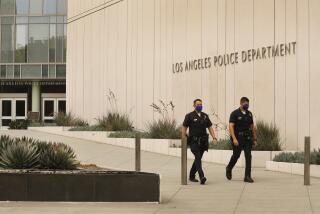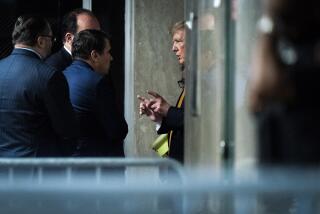L.A. judge orders media not to publish courtroom photos of man charged with killing homeless people
- Share via
A Los Angeles County judge ordered journalists Wednesday not to publish courtroom photographs of a Houston man charged with killing multiple homeless people in the L.A. area, a move that The Times plans to challenge in court as an unconstitutional prior restraint against the media.
Superior Court Judge Gustavo Sztraicher initially told journalists with The Times, the Associated Press and a television news station that he had approved a request to photograph an arraignment hearing for Ramon Escobar.
But as the journalists began photographing or filming the hearing, Sztraicher ordered them to stop when Escobar’s attorney objected and told the judge it could cause an “identification issue.” Sztraicher also told a sketch artist to stop drawing the courtroom scene.
When journalists pressed for clarification, the judge ruled that the publication of any images, videos or sketches of Escobar from the court hearing would be considered a violation of a court order.
Reached by phone Wednesday night, Sztraicher declined to comment.
A Times attorney plans to challenge the order Thursday morning.
The judge’s order comes eight years after an appellate court overturned a similar order prohibiting The Times from publishing photographs of a defendant charged with several counts of murder.
“It is distressing that once again the Los Angeles Times needs to resort to litigation to preserve our rights under the 1st Amendment,” Times Executive Editor Norman Pearlstine said.
California state court judges have wide discretion to allow or bar photos and video in their courtrooms. Defense attorneys often object if there are concerns that publishing photographs of their clients could improperly influence witnesses in a case in which identification is crucial. However, judges generally cannot prevent images from being published once they’re taken legally.
Free-speech experts were quick to contend that the judge’s actions would probably be considered an unconstitutional act of prior restraint.
“Once the photos have been taken, once the photographer has those images in his or her camera, the court’s ability to prevent them from being published is very close to zero,” said David Snyder, executive director of the First Amendment Coalition, a free-speech nonprofit organization.
“Punishment by the government after publication may be acceptable, but any kind of government action, including a court order, that tries to prevent speech or publication from happening before it even happens is especially verboten under the 1st Amendment.”
Media law expert Frank LoMonte noted that judges balance the interest of the public with a defendant’s interest in a fair trial as they decide whether journalists can take photographs of court hearings. But once approval has been given and pictures are taken, a judge generally can’t stop a journalist from publishing, he said.
“If you have gathered images legally and without violating any laws, that footage is yours, period,” said LoMonte, the director of the Brechner Center for Freedom of Information at the University of Florida.
In 2010, a California appellate court overturned a similar order, calling a judge’s actions “an unconstitutional prior restraint on speech.”
In that case, Los Angeles County Superior Court Judge Hilleri G. Merritt had initially granted a Times request to take pictures of Alberd Tersargyan, who was accused of killing four people.
But later in that same proceeding, Merritt withdrew her permission, ordering that The Times not publish the photos after Tersargyan’s lawyer argued that the publication of pictures could jeopardize his ability to get a fair trial.
The judge said she was concerned about issues surrounding the ability of witnesses to identify a suspect in the case.
In overturning Merritt’s decision, a three-judge appellate panel noted that the defense failed to prove Tersargyan’s rights had been jeopardized and pointed out that the media had previously published pictures of him.
In Escobar’s case, Texas authorities have publicly released his mugshot, which has been published by media outlets.
Escobar, 47, is charged with three counts of murder, five counts of attempted murder and four counts of robbery in connection with attacks between Sept. 8 and Sept. 24 on homeless people in Southern California. Authorities say Escobar sneaked up on the sleeping victims and bludgeoned them, sometimes with a wooden baseball bat or a pair of bolt cutters.
More to Read
Sign up for Essential California
The most important California stories and recommendations in your inbox every morning.
You may occasionally receive promotional content from the Los Angeles Times.












